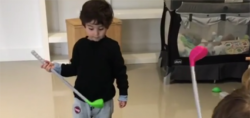Do These Numbers Prove The Golf Industry Is Healthy?

They say one can manipulate all types of numbers to justify a point. As the saying goes, “There are lies, damn lies and statistics.” Golf is no exception. Except, I believe the numbers Golf.com’s Dylan Dethier delivers provides a telling snapshot (both positive and negative) on the current state of our game.
20 — the increase, in percentage, over 2011 in junior golf participation, which came out to roughly 500,000 kids. It’s an increasingly diverse group, too: of all juniors, 33 percent are girls and 33 percent are from non-white backgrounds — both record-high percentages. A good sign as we recently acquired the Rocky Mountain Junior Golf Tour, adding to our Texas Junior Golf Tour).
737 — The net decline in total golf facilities since 2011. Not necessarily a negative. Consolidation in any industry usually makes it healthier and raises the competition.
2300+ — Number of “alternative golf facilities” (practice ranges, miniature golf, and indoor centers) including 1,019 miniature golf facilities and 1,304 driving ranges. Alternative facilities generated $1.131 billion — up from $907.1 million in 2011 — thanks in no small part to the rise of TopGolf.
129,603 — Average dollars spent on capital investment, up from $98,873 in 2011.
23.8 million — Total number of golfers. Of those, 5.8 million (24%) were women and 4.6 million (19%) were non-white.
2.5 million — Number of golfers who played for the first time in 2016, up from 1.5 million in 2011. More potential good news? The number of “latent golfers,” non-golfers interested in playing golf, doubled from 6.4 million to 12.8 million. That’s great news. Yes, the sport has endured some drop outs but as long as new potential avid golfers infuse the game all of us benefit.
210 million — Dollars spent on new golf course construction. That’s down from $516 million in 2011 and WAY down from a high of $5.6 billion in 2000. With the deep pockets assist from housing developers, course numbers exploded in 2000. But like anything else, supply and demand dictate if those builds are sustainable.
1.9 billion — Dollars spent on existing facilities, an increase from 2011.
6 billion — Dollars spent on sales of golf equipment, apparel and supplies.
7.2 billion — Dollars spent on new home construction in golf communities, up from $3.1B in 2011.
25.7 billion — Dollars spent on golf-related tourism in the U.S. in 2016.






